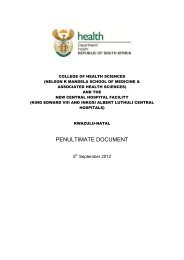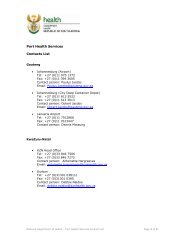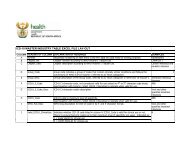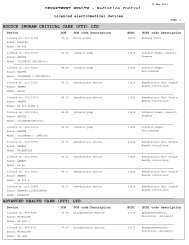National Norms and Standards relating to Environmental Health
National Norms and Standards relating to Environmental Health
National Norms and Standards relating to Environmental Health
You also want an ePaper? Increase the reach of your titles
YUMPU automatically turns print PDFs into web optimized ePapers that Google loves.
3. STANDARDS FOR KEEPING OF ANIMALSPremises used in connection with the keeping of animals must comply with the following requirements:Animals, other than household pets should only be kept in agricultural holdings <strong>and</strong> not on proclaimed<strong>to</strong>wnships.3.1 Requirements for keeping of cattle, horses, mules <strong>and</strong> donkeysa) Cattle, horses, mules <strong>and</strong> donkeys must only be kept in stables designed for keeping of suchanimals.b) Every wall <strong>and</strong> partition of the stable for keeping of cattle, horses, mules or donkeys, must beconstructed of brick, s<strong>to</strong>ne, concrete or other durable material;c) The internal wall surfaces of the stable must be constructed of smooth brick or other durable surfacebrought <strong>to</strong> a smooth finish;d) The height of the walls <strong>to</strong> the wall plates of the stable must –• if the roof is a pitched roof be at least 2,4 metres;• if the roof is a flat roof be at least 2,7 metres;• if the roof is a lean <strong>to</strong> roof be a mean height of at least 3 metres with a minimum of at least 2,4 metreson the lowest side;• in the case of a stable which has an opening along the entire length of one of its long sides be notless than 2 metres;e) The stable must have a floor area of at least 9m² for each head of cattle, horse, mule or donkeyaccommodated in it.f) Lighting <strong>and</strong> ventilation must be provided by openings or glazed opening windows or louvers <strong>to</strong>tallingat least 0,3 m² for each animal <strong>to</strong> be accommodated in it except in the case of a stable open alongthe entire length of one of its long sides.g) The lowest point of every opening, window or louvers must be at least 1, 8 metres, above floor level.h) The floor of the stable must be constructed of concrete or other durable <strong>and</strong> impervious materialbrought <strong>to</strong> a smooth finish graded <strong>to</strong> a channel <strong>and</strong> drained.i) An enclosure must have an area of at least 10m² for each head of cattle, horse, mule or donkeyaccommodated in it <strong>and</strong> the fencing must be strong enough <strong>to</strong> prevent the animals from breaking out.j) No enclosure or stable may be situated within –• At least 15 metres of the boundary of any l<strong>and</strong>, property, dwelling or other structure used for humanhabitation; or• At least 50 metres of any water resource or water supply intended or used for human consumption;<strong>and</strong>• There must be a water supply adequate for drinking <strong>and</strong> cleaning purposes next <strong>to</strong> every stable orenclosure.3.2 Hygiene st<strong>and</strong>ards for keeping of cattle, horses, mules <strong>and</strong> or donkeysa) The premises, <strong>and</strong> any equipment, apparatus, container or receptacle used in connection withkeeping the animal must be kept in a clean <strong>and</strong> sanitary condition <strong>and</strong> in good repair.b) Portable manure s<strong>to</strong>rage receptacles of an impervious material with close fitting lids must beprovided.c) Every manure s<strong>to</strong>rage receptacle must be kept on a platform constructed of concrete or other durable<strong>and</strong> impervious material near the stable or enclosure.d) If there is so much manure <strong>and</strong> bedding those s<strong>to</strong>rage receptacles is impractical, a manure containeror area must be provided on the premises.e) The manure container or area must be roofed <strong>and</strong> enclosed by three walls constructed of brick,concrete or other durable material plastered <strong>to</strong> a smooth finish.f) The floor of the manure area must be of smoothly finished concrete that is inclined so that it drains <strong>to</strong>a water channel along the full length of the open side, which is at least 150 mm in a diameter <strong>and</strong> iskept filled with water.g) Manure must be removed from the stable <strong>and</strong> enclosure at least once every 24 hours <strong>and</strong> placed inthe manure s<strong>to</strong>rage receptacles or manure container or area until it is removed from the premises (ifDOH. <strong>Norms</strong> <strong>and</strong> st<strong>and</strong>ards for environmental health in South Africa Feb 2013 60






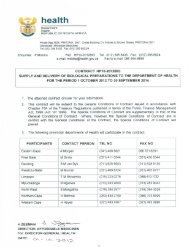
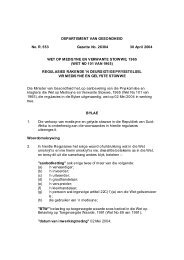
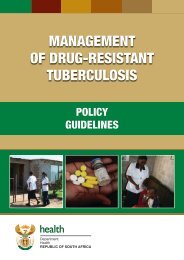
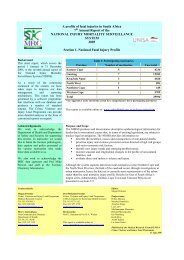
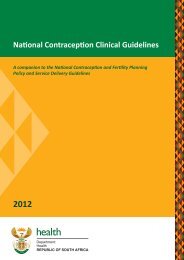
![A monograph of the management of postpartum haemorrhage [2011]](https://img.yumpu.com/15578784/1/184x260/a-monograph-of-the-management-of-postpartum-haemorrhage-2011.jpg?quality=85)
